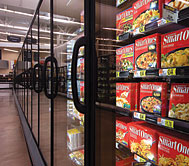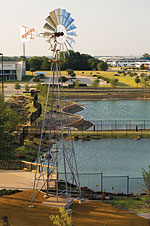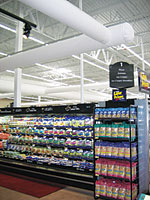
But the products at good prices are enclosed in what is being called a state-of-the-art campus with more than two-dozen new, environmentally correct, and energy-efficient experimental technologies, including a number in the HVACR systems.
As shoppers enter the store, they can pick up a "treasure map" that guides them through the store and parking lot in search of those technologies. Some of the most obvious ones on the outside are ponds used to capture rainwater, which is then used to water trees and plants in dry times. It is aided by a small windmill and a wind turbine nearly half the height of the Statue of Liberty, designed to reduce the consumption of electricity from utility companies.
Inside the building, customers see refrigerated display cases with light emitting diode (LED) rather than fluorescent lighting, designed to accent the natural colors of products. Heat radiates from flooring around the frozen food cases, keeping customers' toes warm.
Here are some of the things they don't see: used oil and leftover construction materials. Oil once used to fry foods and used motor oil from the auto shop are collected for use in a bio-fuel boiler. Some of the construction materials and waste from the building process ended up in the sidewalks.
"We want to make the best use of renewable and alternative sources like wind and solar energy to generate electricity to supplement the power needs of the store," said Don Moseley, P.E., Wal-Mart's experimental projects manager.
"The store at McKinney draws its energy first from on-site resources and systems, then from conventional utility sources as a secondary service."
Refrigeration
Five Hill Phoenix DX packaged units are used for refrigeration. Rather than being placed in a back room or in outdoor housing at the rear of the store, the units are spread out on the roof over the section of the store with the coolers and freezers.Hill Phoenix describes this as a short-coupled, distributed refrigeration system. The system was designed to reduce the amount of copper piping and refrigerant (R-404 in both medium and low temperature units) needed to cool cases in the store.
The systems reduce the amount of linear feet of piping required by about 45 percent and also reduce the amount of refrigerant by about 45 percent, said Ernie Northern, HillPhoenix's national account manager for the Wal-Mart support team.
The cooling system design also uses high-efficiency evaporative cooling towers that supply chilled water to the refrigeration system while using water-cooled condensers. The result, said Northern, is a reduction of both connected horsepower (about 104 hp) and energy (about 654,000 kWh annually).

Hill Phoenix equipment also is used in a two-stage heat reclamation process that was integrated in the radiant floor heating system.
The company's mechanical-electrical design team created the system to recover waste heat and transfer it to a fluid that is circulated throughout the radiant floor. (The radiant floor heating is also used in the checkout area, where employees have to stand in one spot for long periods of time.)
The display cases came from Hill Phoenix, Hussmann, and Carrier Tyler.
According to Moseley, open cases are used for such products as meats and eggs, which customers want to examine more closely before purchasing. The closed cases are used for pre-packaged products that require less time to view, thus less time for doors to be left open.
LED lighting is installed in the cases in place of fluorescent strip fixtures. Moseley said the LED technology has a longer life span than fluorescent lights, and they produce less heat and use less energy. The new lighting also better shows the true color of products, he said.
Kool-Touch Refrigeration of Garland, Texas, was the installing contractor for the distributed refrigeration system.

Air Conditioning And Ventilation
CBS Mechanical, a contractor from nearby Denton, installed the R-410A rooftop air conditioning system from AAON Inc. The air conditioning and ventilation aspect also included make-up air dehumidification from Munters Corp. and a fabric duct system from DuctSox.According to officials at DuctSox, the McKinney store's cooling load is 380 tons, about 70 tons less than typical for stores the size of Wal-Mart (206,000 square feet) in southern states. Much of the reduced cooling tonnage is the result of displacement ventilation on the sales floor made possible by the fabric duct, said Sean Timmons of Timmons Design Engineers. The company was involved in some mechanical, electrical, and plumbing aspects of the store.
The duct is mounted 11 feet above the sales floor so that it "cools just the bottom half of the store where it is needed most," Timmons said. A linear array of holes deliver supply air at what is considered a draftless low velocity and moderate temperature of 65 degrees to 68 degrees. After falling to the floor and mixing with air warmed by occupants and other heat sources, the air rises slowly to the upper level of the store. Ceiling-mounted return registers recycle the air back to the rooftop units, where it is mixed with outdoor air.

Heating And Controls
Heat is recovered from the parallel compressor racks. Part of the process provides free water heating via a Bryan 1.2-mbh boiler that supplies domestic hot water for the bathrooms and the radiant heating system from Uponor Wirsbo.Waste cooking oil and waste motor oil were included in the power equation for the 500,000-Btu Energy Logic boiler, which provides supplemental heating through reheat coils in the store's make-up air handlers.
Novar Retail installed a Logic One® system to control the store's HVAC system, interior and exterior lighting, and signage. The Spectrum® Advanced control system monitors and controls the temperature and operation of refrigerated coolers and cases.
More To Come
Mike Duke, executive vice president and chief executive officer for Wal-Mart Stores-USA, said, "We see it as a next step in evaluating the impact we leave on the environment as we look toward smart growth and sustainability in the building of our new stores."The company is planning on putting up another experimental store in Aurora, Colo., which is expected to open later in the fall. Some officials in McKinney said that store might introduce even more technologies. On the refrigeration side, that includes secondary-loop glycol systems for the medium-temperature fixtures and coolers, and R-404A DX systems for low-temperature fixtures.
Publication date: 09/05/2005


